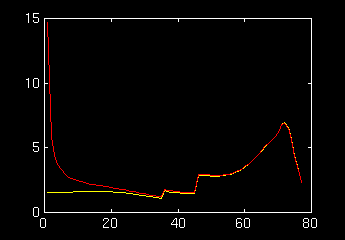 |
 |
This simulation is done in a purely kinematic way, that is I've tried to figure out how I'm actually moving while doublepoling that is how the elbow angles, wrist angles and so on changes during one stroke.
Well what are we supposed to learn, or is it possible to learn something or even anything from this simple cartoon. The assumption here are that the skier makes exactly the same motion when double poling with poles of different lengths, that is of course a crude approximation based on the idea that you plant the poles when your hands are in the same possition relative to the body, but might give some insigth of what its all about...
A first try to see the importance of the polelength on the speed and efficiency of a double pole stroke is to study the distance traveled by the skier during the stroke.
 In these 2 graphs the x-axis is time in arbitrary untits - not far from hundreds of a second though,
the y-axis in the first graph is cm and in the other cm/time.
Here I've compared the length traveled down the track (center of mass) during one stroke
with 2 different lengths of the poles ( 157.5/165.0 cm ) the red line is poling
with 157.5 and yellow is 165. Here it seems as if the shorter pole give more
distance per stroke. This is somewhat suprising to me.
In these 2 graphs the x-axis is time in arbitrary untits - not far from hundreds of a second though,
the y-axis in the first graph is cm and in the other cm/time.
Here I've compared the length traveled down the track (center of mass) during one stroke
with 2 different lengths of the poles ( 157.5/165.0 cm ) the red line is poling
with 157.5 and yellow is 165. Here it seems as if the shorter pole give more
distance per stroke. This is somewhat suprising to me.
The explanation to that emerges when we look at the velocity for the c.o.m. during the
motion.
 Here once again the red is the velocity (c.o.m.) during the motion when double poling
with 157.5 cm poles and yellow is 165 cm. The most signifficant and "eye-grabbing"
difference between the 2 curves are that the velocity ( along the track ) decreases
during the first period of the motion when poling with 157.5. The other feature
is the 2 semi discrete accelerations during the midpart of the motion. The second feature
highlights the weakest spot of this kinematic approach. These steplike features indicate
that my motion-model has its clear short-commings, this kind of features is from physical
point of view fairly unrealistic. The first decrease in velocity, something that is
unlikely to be a true model of what's going on, on the other hand points out that the
first assumption about planting poles of different lengths when the hands are in the same
possition is not valid.
Here once again the red is the velocity (c.o.m.) during the motion when double poling
with 157.5 cm poles and yellow is 165 cm. The most signifficant and "eye-grabbing"
difference between the 2 curves are that the velocity ( along the track ) decreases
during the first period of the motion when poling with 157.5. The other feature
is the 2 semi discrete accelerations during the midpart of the motion. The second feature
highlights the weakest spot of this kinematic approach. These steplike features indicate
that my motion-model has its clear short-commings, this kind of features is from physical
point of view fairly unrealistic. The first decrease in velocity, something that is
unlikely to be a true model of what's going on, on the other hand points out that the
first assumption about planting poles of different lengths when the hands are in the same
possition is not valid.
This kinematic approach was not good enough, I hope to be able to make real measurements of doublepoling in the future, but when it comes to the dynamic study of the energy efficiency of doublepoling with different lengths - well that is beyond the scope of this study.
Comments, suggestions, ideas or You just want to flatter me, You are welcome..